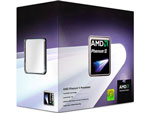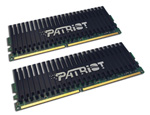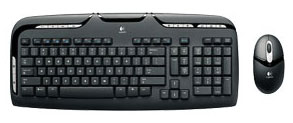AMD HTPC
Everyone asks for HTPC component recommendations, but those potential HTPC buyers seem almost impossible to please. Perhaps this is because the HTPC, more than any other computer class, is a very personal machine. It needs to meet the specific needs and demands of the end users, who vary widely in what they plan to do with their new HTPC.
So let's first talk about our build concept for these two HTPC configurations, which remain very similar to the recommendations in our last entry guide. We are assuming the user already has the HDTV or monitor he plans to feed, along with a sound system for that HDTV. The motherboards we recommend can reasonably feed audio signals for your Blu-ray movies, but they are not integrated audio amplifiers. Since most end-users are on cable or satellite for TV, we will not include any TV tuner recommendations. In other words, our HTPC recommendation is a "white box" recommendation. We do understand that some users want more detail and more options in our HTPC recommendations so we plan to do an expanded HTPC Buyers' Guide in the future.
Of the many possible uses for an HTPC, the majority of end-users store, play, and stream movies with their HTPCs. Thus, that is where we have concentrated our recommendations. In general, the processing power in both systems has increased since our December 2008 guide, but as performance increases costs have fortunately continued to drop. This is particularly true in our new case recommendation from Antec, which provides a "component look" case and silent 80 Plus certified 380W power supply for $120.
| AMD HTPC System | ||
| Hardware | Component | Price |
| Processor | AMD Phenom II X3 710 Deneb (Tri-core 2.6GHz, 45nm, 3x512KB L2, 6MB Shared L3) |
$119 |
| Cooling | CPU Retail HSF | - |
| Video | On-Board | - |
| Motherboard | ASUS M3N78-EM GF8300 Micro ATX | $90 |
| Memory | Patriot Viper Model PVS24G6400LLK 4GB DDR2-800 4-4-4 ($52 less $25 Rebate) |
$27 |
| Hard Drive | WD Caviar Green WD10EACS 1TB 32MB cache - OEM | $90 |
| Optical Drive | LG BD/HD DVD / 16x DVD+/- RW GGC-H20L - Retail | $110 |
| Audio | On-Board | - |
| Case | Antec NSK2480 Black/Silver Micro ATX Case Includes 80 Plus Certified 380W PSU |
$120 |
| Power Supply | Earthwatts 380W Included with Case | - |
| Base System Total | $555 | |
| Input | Logitech Cordless Desktop EX110 USB RF Wireless Keyboard and Optical Mouse |
$30 |
| Operating System | Microsoft Vista Home Premium SP1 (for System Builders) | $99 |
| Complete System Bottom Line | $685 | |
 |
The CPU chosen for the AMD HTPC is the tri-core Phenom II X3 710 with 6MB of shared L3 cache. You get the expanded processing power of the Phenom II, which is always useful in an HTPC, at the same price as the older Phenom CPU chosen in the last HTPC guide. The three cores each run at 2.6GHz, each has a 512KB L2 cache, and you get a shared 6MB L3 cache - the same L3 cache size shared on higher end quad-core Phenom II processors. We hesitate to call a Phenom II X3 CPU a low-end chip, but this is certainly the most reasonable Phenom II you can buy. However, it has plenty of power to take your AMD HTPC anywhere you choose to go.
 |
With DDR2-800 still a reasonable option these days, we equipped the HTPC with 4GB of fast CAS4 Patriot Viper memory. We aren't interested in overclocking this HTPC (though it's technically still possible), and spending additional money on even higher performance RAM just doesn't make sense. 4GB of memory, however, does make perfect sense in an HTPC box.
 |
The $90 ASUS M3N78-EM is based on the NVIDIA GeForce 8300 chipset. The board features one PCI-E x16 slot, one PCI-E x1 slot, two PCI slots, 8GB memory support, NVIDIA Gigabit LAN, 7.1 HD audio, 12 USB ports, five 3Gb/s SATA ports with RAID support, IEEE 1394a, one eSATA port, HDMI/DVI/VGA output, and full support for Phenom 140W processors. This board offers overclocking capabilities along with being a top-notch HTPC board. We highly recommend the GF8200/8300 series for the HTPC market due to hardware accelerated Blu-ray playback, multi-channel LPCM output, and very good application performance.
 |
As we discussed in the HTPC introduction we did not include a TV tuner in the configuration since most end users are now distributing their cable and satellite feeds. Few users, therefore, have any real need for a TV tuner card. If you truly need a Digital TV tuner, one interesting option on the TV tuner side is the HD HomeRun from Silicondust USA. This dual HDTV tuner/recorder functions over a network and provides ATSC/QAM support. The price of $159 is more than many other options, but this is arguably a more flexible overall solution - particularly with the mandated move to digital from analog.
What's the point of having an HTPC if you don't have a lot of storage space? To that end, we selected a newly affordable 1TB (1000GB) Western Digital Caviar Green WD10EACS SATA hard drive at just $90. The WD Green features an energy saving design and we found to be among the quietest drives we have ever evaluated. For an HTPC, silence is paramount, and this WD Green will not disappoint. The WD Green is a bit slower than 7200RPM 1TB drives, but the real performance difference is very minor - especially if you're only interested in HTPC duties like video storage and playback.
Seagate also makes a super-reliable 1TB drive optimized for video storage and retrieval called the Seagate SV35.3 ST31000340SV 1TB at $150. This "video" Seagate features 24x7 reliability with >1 million hours MTBF and improved read/write reliability. For those willing to pay the small premium for this drive, the "video" Seagate would be a good choice. The Seagate includes a 5-year warranty.
 |
The Optical Drive is certainly an upgrade to the entry and budget systems since a reasonable HTPC requires Blu-ray playback capabilities. The LG Blu-ray drive fits the bill without breaking the bank. It provides 6X Blu-ray playback and the fastest recording and playback of DVD and CD media. The current price is around $110, but this drive sometimes goes on sale for $100 so look out for specials.
There are also Blu-ray options from Lite-On for less than $100 and a 6X Blu-ray player at $105. We do not have much experience with this Lite-On drive, but Lite-On drives in the past have proved reliable. That would make the Lite-On 6X Blu-ray a more reasonably priced alternative where every penny counts.
 |
Our choice for the HTPC case is the Antec New Solution NSK2480 with its audio component look, and it includes an extremely flexible design for a micro ATX motherboard. The case features an Earthwatts 80 Plus 380W power supply and two side-mounted 120mm TriCool 3-speed fans. It supports two front-accessible 5.25" drives and two internal 3.5" drives. An adjustable internal baffle system lets you direct the airflow for best cooling.
If you prefer a small cube case, the Lian Li PC-V350B is a gem of a small black aluminum case. The Lian Li is also a great choice for those who prefer a cube instead of a component look.
 |
Since most will place their HTPC near their HDTV or big screen monitor, a wired keyboard and mouse are not very useful in most setups. More often, you'll want to control the PC from across the room, so we selected a wireless RF Logitech keyboard and mouse. At just $30 for the pair, the Logitech Cordless Desktop EX110 USB RF wireless package is a great value. This is also the HTPC preferred RF wireless set, which does not require "line of sight" that is needed for IR wireless.
The final price of the AMD HTPC comes to just $685. That is a bargain considering the tri-core Phenom II CPU, 4GB of memory, and 1TB hard drive, all housed in a quiet Antec HTPC case with an 80 Plus certified PSU. You can certainly spend even less on a basic HTPC box, but we doubt you can build a more powerful or quieter system for the same money.










65 Comments
View All Comments
bupkus - Tuesday, May 19, 2009 - link
Could you list a Crossfire motherboard option for those who think of a budget system as one that would allow a second HD4770 for future upgrade?Gary Key - Wednesday, May 20, 2009 - link
Hi,Unlike the AMD side, there are not any standout CF boards that fit within our budget guidelines for this article. That said, I like the DFI BI P45-T2RS at $107, ASRock P45XE at $90, Biostar TForce TP45HP at $100, and my favorite P45 board, the Gigabyte GA-EP45-UD3P at $130 but $110 with a rebate right now.
With the last BIOS update, the DFI LP JR P45-T2RS at $110 is an interesting choice as it is an uATX format and works well in a SFF system, especially with two HD4770 cards. I have not tested the ECS BS P45T-A, but it seems to have positive comments around the forums (looking at price compared to performance/quality) for $82 with the MIR.
Wesley Fink - Tuesday, May 19, 2009 - link
For an AMD CPU there are lots of good Crossfire X motherboard choices. One geed choice is the Asus M4A78 Plus which sells for just $79 so it still fits the budget very well.Choosing an Intel board with dual PCIe x16 slots is a lot more difficult. I have asked Gary Key, our Motherboard Editor, to comment on an Intel choice.
PC Reviewer - Monday, May 18, 2009 - link
id change the video card to an hd 4890 if you could throw in the extra money..http://pcreviewer.org/new-radeon-hd-4890-video-car...">http://pcreviewer.org/new-radeon-hd-4890-video-car...
Lunyone - Monday, May 18, 2009 - link
As the previous poster stated that the Gigabyte g41 mobo listed has only 2 DIMM slots and not 4 as pictured in the article. This is one of the main reasons I prefer AMD mobo's over most Intel based mobo's. AMD's mobo's "usually" have more options included for a given price (usually less than Intel based ones). This isn't always true, but I'd say that 80-90% of the time it is true.Anyone know of any good links to the Sigma 500w PSU?? I'm just curious how well it does under testing or in real world situations. I try and keep up on good PSU's and I'm having a hard time finding reviews for the Sigma PSU listed in this review. I've read some on their other offerings >650w, but can't seem to find one for the 500w level.
Wesley Fink - Tuesday, May 19, 2009 - link
We had the correct Gigabyte G41 photo in the images, but the wrong link. THat has been corrected and you will now see the small image with the two dimm slots, which is all available on the $65 G41 MB.The 2 dimm slots can easily handle our recommended 4GB of memory. If you want more than 4GB you will need a more expensive motherboard.
Shocker1322 - Sunday, May 17, 2009 - link
I happen to be specing out a computer that is also using the GA-G41M-ES2L, however the picture posted looks to be that of a GA-EP45-UD3R. A key difference is the 4 DIMM slots on the GA-EP45-UD3R vs the 2 DIMM slots on the GA-G41M-ES2L.PrinceGaz - Friday, May 15, 2009 - link
I know the main point of this article was main system recommendations, but I would suggest you do some basic research before recommending some of the other bits to go with it.The recommendation of the Logitech EX110 wireless keyboard and mouse set literally left me open-mouthed. Just because it has the Logitech name doesn't mean it is a quality product. I had an EX110 for a day. The keyboard was DOA, and the mouse both felt and acted like the very cheap optical mouse it was (when left stationery, the mouse pointer slowly creeped to one side, and sometimes the mouse pointer jumped to the edge of the screen). And that's before the batteries. The EX110 is known to eat batteries very quickly, so you should add the cost of some NiMH rechargeables (and the charger if necessary) to the system build cost. My overall impression of it (the keyboard didn't work but I still got a feel for how the keyboard felt) was that it was bargain-bin no-name product, which Logitech have foolishly stuck their name on to capture some of the low-end market.
Spend a touch more on the keyboard and mouse and you can get products which perform much better, like the LX-6 mouse which can run off a single AA cell for two or three months of heavy use (or you can put two in for double the life as they are connected in parallel), instead of using two of them in a week or so. As for the keyboard, any RF wireless keyboard with sufficient range should be fine as even the cheap ones don't eat batteries (there is no potentially power-draining LED or laser needed on a keyboard), and an HTPC is unlikely to be used for serious typing duties.
Apart from that small point about what I guess was a blind "this is cheap and is wireless from a good company" recommendation of the EX-110, it was an excellent article.
Ah yeah, one other thing made me smile: on the page 3 (Intel entry-level) about the Asus P5QL-CM mobo:
"It is not an overclocking demon with our E5200/E7200 being limited to the 345FSB range due to the chipset, but that is more than enough headroom (4.16GHz with the E5200) for most users."
This is the entry level system costed at around US$300 for the base system, and you feel the need to mention the recommended CPU with that mobo will probably not be able to be overclocked beyond 4.16GHz from its stock 2.5GHz! Good grief, if it were an overclocking-system guide, then you might mention that, buy you are talking about what is an over 70% overclock limitation in what is an entry-level box! Seriously-- a 70% overclock limitation because of the mobo in an entry-level box.
strikeback03 - Monday, May 18, 2009 - link
We have bought 3 of the EX110 sets for student computers here at work. All have worked on arrival, and none eat batteries excessively (couple months per charge). The keyboard isn't the highest quality, but my biggest concern for HTPC use would be the range. They seem to be limited to a few feet, which would mean the receiver would have to be buried in the couch or something.pirspilane - Wednesday, May 27, 2009 - link
Yes, the range is a problem. The EX110 is better suited for desktop use.I put the RF receiver on the top rear of my armoire, since the cord wouldn't reach to the front. Reception was erratic from only 6 feet away.
It works OK now that I moved the receiver to the front of the armoire on top of the TV shelf.